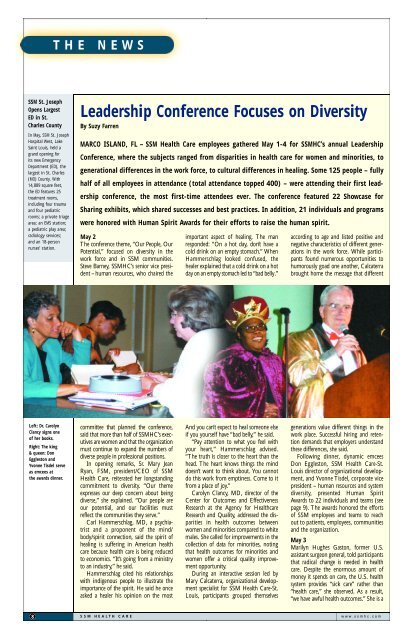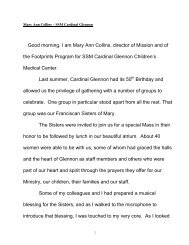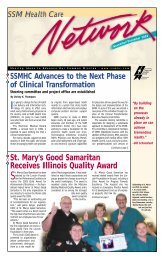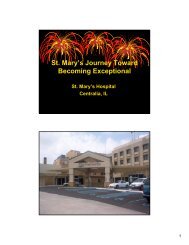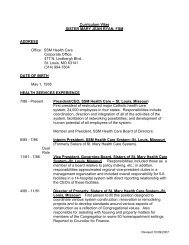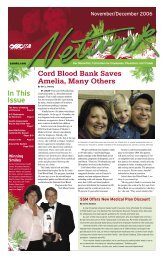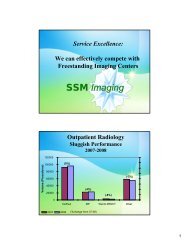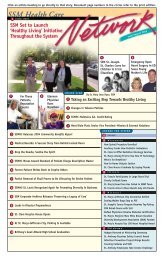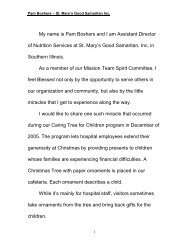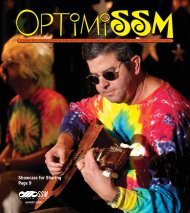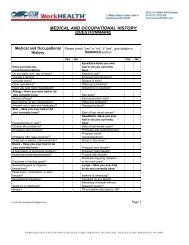You also want an ePaper? Increase the reach of your titles
YUMPU automatically turns print PDFs into web optimized ePapers that Google loves.
T H E N E W S<strong>SSM</strong> St. JosephOpens LargestED in St.Charles CountyIn Ma y, <strong>SSM</strong> St. Jo s e p hHospital West, LakeS a i nt Louis, held ag ra nd opening forits new Eme rge nc yD e p a r t me nt (ED), thel a rgest in St. Charles( MO) Count y. With14,889 squa re feet,t he ED features 25t re a t me nt ro o ms,i nc l ud i ng four tra u maa nd four pedia t r icro o ms; a private tria gea rea; an EMS statio n ;a pedia t r ic play are a ;ra d iology services;a nd an 18-personnurses’ statio n .L e a d e rship Conference Focuses on Dive rs i t yBy Suzy Fa r re nMARCO ISLAND, FL – <strong>SSM</strong> <strong>Health</strong> <strong>Care</strong> employees gathered <strong>May</strong> 1-4 for <strong>SSM</strong>HC’s annual LeadershipConference, where the subjects ranged from disparities in health care for women and minorities, togenerational differences in the work force, to cultural differences in healing. Some 125 people – fullyhalf of all employees in attendance (total attendance topped 400) – were attending their first leadershipconference, the most first-time attendees ever. The conference featured 22 Showcase forSharing exhibits, which shared successes and best practices. In addition, 21 individuals and programswere honored with Human Spirit Awards for their efforts to raise the human spirit.<strong>May</strong> 2The conference theme, “Our People, Ou rPotential,” focused on diversity in thew o rk force and in <strong>SSM</strong> communities.St e ve Ba r n e y, <strong>SSM</strong>HC’s senior vice pre s i-d e n t– human re s o u rces, who chaired thei m p o rtant aspect of healing. The manresponded: “On a hot day, don’t have acold drink on an empty stomach.” W h e nHammerschlag looked confused, theh e a ler explained that a cold drink on a hotday on an empty stomach led to “bad b e l l y. ”a c c o rding to age and listed positive andn e g a t i ve characteristics of different generationsin the work force. While part i c i-pants found numerous opportunities toh u m o rously goad one another, Calcaterrab rought home the message that differe n tLeft: Dr. Caro l y nC l a n cy signs oneof her books.Right: The king& queen: DonEggleston andYvonne Tisdel serveas emcees atthe awa rds dinner.committee that planned the confere n c e ,said that more than half of <strong>SSM</strong>HC’s exe c-u t i ves are women and that the organizationmust continue to expand the numbers ofd i verse people in professional positions.In opening re m a rks, Sr. Ma ry Je a nRyan, FSM, president/CEO of <strong>SSM</strong><strong>Health</strong> <strong>Care</strong>, reiterated her longstandingcommitment to dive r s i t y. “Our themee x p resses our deep concern about beingd i verse,” she explained. “Our people areour potential, and our facilities mustreflect the communities they serve.”Carl Hammerschlag, MD, a psyc h i a-trist and a proponent of the mind/body/spirit connection, said the spirit ofhealing is suffering in American healthc a re because health care is being re d u c e dto economics. “It’s going from a ministryto an industry,” he said.Hammerschlag cited his re l a t i o n s h i p swith indigenous people to illustrate thei m p o rtance of the spirit. He said he onceasked a healer his opinion on the mostAnd you can’t expect to heal someone elseif you yourself have “bad belly,” he said.“ Pay attention to what you feel withyour heart,” Hammerschlag advised.“The truth is closer to the heart than thehead. The heart knows things the mindd o e s n’t want to think about. You cannotdo this work from emptiness. Come to itf rom a place of joy.”C a rolyn Clancy, MD, director of theCenter for Outcomes and Ef f e c t i ve n e s sRe s e a rch at the Agency for He a l t h c a reRe s e a rch and Qu a l i t y, addressed the disparitiesin health outcomes betwe e nwomen and minorities compared to whitemales. She called for improvements in thecollection of data for minorities, notingthat health outcomes for minorities andwomen offer a critical quality improvementopport u n i t y.During an interactive session led byMa ry Calcaterra, organizational deve l o p-ment specialist for <strong>SSM</strong> <strong>Health</strong> <strong>Care</strong> - St .Louis, participants grouped themselve sgenerations value different things in thew o rk place. Successful hiring and re t e n-tion demands that employers understandthese differences, she said.Fo l l owing dinner, dynamic emceesDon Eggleston, <strong>SSM</strong> <strong>Health</strong> <strong>Care</strong> - St .Louis director of organizational deve l o p-ment, and Yvonne Tisdel, corporate vicep resident – human re s o u rces and systemd i ve r s i t y, presented Human Sp i r i tAw a rds to 22 individuals and teams (seepage 9). The awards honored the effort sof <strong>SSM</strong> employees and teams to re a c hout to patients, employees, communitiesand the organization.<strong>May</strong> 3Marilyn Hughes Gaston, former U.S.assistant surgeon general, told part i c i p a n t sthat radical change is needed in healthc a re. Despite the enormous amount ofmoney it spends on care, the U.S. healthsystem provides “sick care” rather than“health care,” she observed. As a re s u l t ,“we have awful health outcomes.” She is a8 S S M H E A L T H C A R E w w w . s s m h c . c o m


